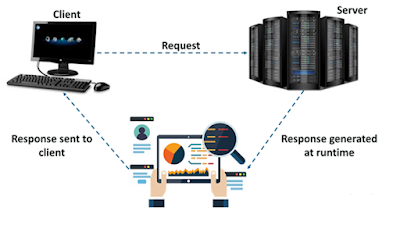What is a web application?
A web application is an application accessible from the web. A web application is composed of web components like Servlet, JSP, Filter, etc. and other elements such as HTML, CSS, and JavaScript. The web components typically execute in Web Server and respond to the HTTP request.
Google, Facebook, Twitter are examples of web applications.
CGI (Common Gateway Interface)
CGI technology enables the web server to call an external program and pass HTTP request information to the external program to process the request. For each request, it starts a new process.
Servlet Life Cycle:
The entire life cycle of a servlet is managed by the Servlet container which uses the javax.servlet.
Servlet interface to understand the Servlet object and manage it.
Servlet Life Cycle: The Servlet life cycle mainly goes through four stages:
•Loading a Servlet
When a server starts up, the servlet container deploy and loads all the servlets.
•Initializing the Servlet
Next, a servlet is initialized by calling the init() method. Servlet.init() method is called by the Servlet container to notify that this Servlet instance is instantiated successfully and is about to put into service.
public void init(ServletConfig config) throws ServletException
•Request handling
Then, servlet calls service() method to process a client’s request and is invoked to inform the Servlet about the client requests. If servlet is initialized, it calls the service method. Notice that servlet is initialized only once. The syntax of the service method of the Servlet interface is given below:
public void service(ServletRequest request, ServletResponse response) throws ServletException, IOException
•Destroying the servlet
Finally, a servlet is terminated by calling the destroy(). The destroy() method runs only once during the lifetime of a Servlet and signals the end of the Servlet instance.init() and destroy() methods are called only once.
The syntax of the destroy method of the Servlet interface
is given below:public void destroy()
Example Program on Servlet:
import
java.io.*;
import
javax.servlet.*;
import
javax.servlet.http.*;
//
Extend HttpServlet class
public
class
MyServlet
extends
HttpServlet
{
private
String
output;
//
Initializing servlet
public
void
init()
throws
ServletException
{
output
= "Advance
Java Concepts";
}
//
Requesting and printing the output
public
void
doGet(HttpServletRequest
request,
HttpServletResponse
response)
throws
ServletException,
IOException
{
response.setContentType("text/html");
PrintWriter
out = response.getWriter();
out.println(output);
}
public
void
destroy()
{
System.out.println("Over");
}
}
JSP : JSP technology is used to create web application just like Servlet technology. It can be thought of as an extension to Servlet because it provides more functionality than servlet such as expression language, JSTL, etc. A JSP page consists of HTML tags and JSP tags. The JSP pages are easier to maintain than Servlet because we can separate designing and development.
Advantages of JSP over Servlet:
•JSP codes are easy to write and maintain.
•Development speed becomes fast, and there is no need for recompilation and redeployment.
•It has high performance and scalability compared to other dynamic web development tools.
•JSP is constructed on Java technology, which makes it platform-independent.
JSP technology is used to create dynamic web Applications. JSP pages are easier to maintain then a Servlet. JSP pages are opposite of Servlets as a servlet adds HTML code inside Java code, while JSP adds Java code inside HTML using JSP tags. Everything a Servlet can do, a JSP page can also do it. JSP enables us to write HTML pages containing tags, inside which we can include powerful Java programs. Using JSP, one can easily separate Presentation and Business logic as a web designer can design and update JSP pages creating the presentation layer and java developer can write server side complex computational code without concerning the web design. And both the layers can easily interact over HTTP requests.
Why JSP is proffered over servlets?
•JSP provides an easier way to code dynamic web pages.
•JSP does not require additional files like, java class files, web.xml etc
•Any change in the JSP code is handled by Web Container(Application server like tomcat), and doesn't require re-compilation.
•JSP pages can be directly accessed, and web.xml mapping is not required like in servlets.
What is JSP LifeCycle?
JSP Life Cycle is defined as translation of JSP Page into servlet as a JSP Page needs to be converted into servlet first in order to process the service requests. The Life Cycle starts with the creation of JSP and ends with the disintegration of that.
The life cycle of a JSP page can be divided into the following phase:
1.Translation Phase
2.Compilation Phase
3.Initialization Phase
4.Execution Phase
5.Destruction(Cleanup) Phase
Let us understand these steps in detail.
1.Translation Phase








No comments:
Post a Comment